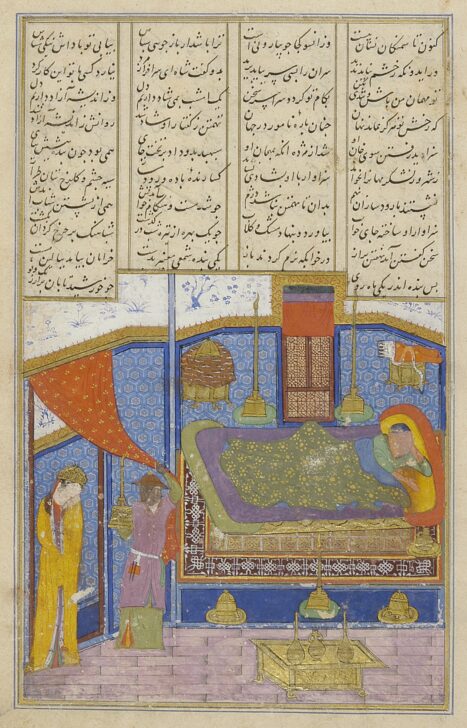Tahmina Comes to Rustam, from the Shahnama of Firdausi
Iranian

Description
Once when Rustam went out hunting alone in Turan, his great horse Rakhsh was stolen by thieves at night. Rustam found his way to Samangan (modern Samarkand), where he was warmly welcomed by the king. That night, he was awakened from a drunken stupor when a beautiful maiden entered his chamber.
At noon of night, while Phospor crossed the sky,
There came mysterious whispers. Rustam’s door
Was softly opened, and a slave who bore
A taper savoring of ambergris
Walked stately towards the drunken sleeper’s couch.
Behind the slave there was a moon-faced girl
Sun-bright, all scent and hue, with arching eyebrows
And locks that hung in tresses lasso-like,
In stature like a lofty cypress-tree. …
The lion-hearted Rustam marveled at her
And calling on the Maker asked: “Thy name?
What seek’st thou midst the murk of night? Thy will?”
She said: “Tahmina: and thou well mayst say
That mine affliction teareth me in twain.
Sole daughter of the king of Samangan,
And by descent half lion and half pard,*
There is no mate for me among the kings,
Nor are there many like me under heaven.
But many and many a story have I heard
Of thee …
… And now if thou wilt have me I am thine. …”
Warner, II, 123–24
Rustam and Tahmina were married that night, but Rustam departed the very next day for his homeland. From this one-night encounter Tahmina bore a son, Suhrab, who appears in the next illustration (1963/1.47).
Note how the artist has evoked the luxury of Rustam’s quarters, with blue-and-gold glazed tile walls, a pierced-stone window, a brick floor, and golden furnishings. Beyond the walls we can see a garden, with delicately brushed blue flowers on a white ground, suggesting the effect of plants seen in the moonlight.
* pard: an archaic term for leopard
———
Maribeth Graybill, Senior Curator of Asian Art
Exhibited in "A Medieval Masterpiece from Baghdad: the Ann Arbor Shahnama"
August 14 through December 19, 2004
Subject Matter:
Tahmina Comes to Rustam
At noon of night, while Phosphor crossed the sky,
There came mysterious whispers, Rustam's door
Was softly opened, and a slave who bare
A taper savouring of ambergris
Walked stately toward the drunken sleeper's couch.
Behind the slave there was a moon-faced girl
Sun-bright, all scent and hue, with arching eyebrows
And locks that hung in tresses lasso-like....
The lion-hearted Rustam marvelled at her
And calling on the Maker asked: "Thy name?
What seek'st thou midst the murk of night? Thy will?"
She said: "Tahmina: and thou well mayst say
That mine affliction teareth me in twain.
...And now if thou wilt have me I am thine..."
Physical Description:
Timurid miniature from the Shiraz and Timurid schools, ca. 1460. The painting is done in ink, opaque watercolor and gold leaf on paper. The scene depicts Tahmina Comes to Rustam from the Shahnama of Firdausi, the Persian book of kings.
Usage Rights:
If you are interested in using an image for a publication, please visit https://umma.umich.edu/request-image/ for more information and to fill out the online Image Rights and Reproductions Request Form.